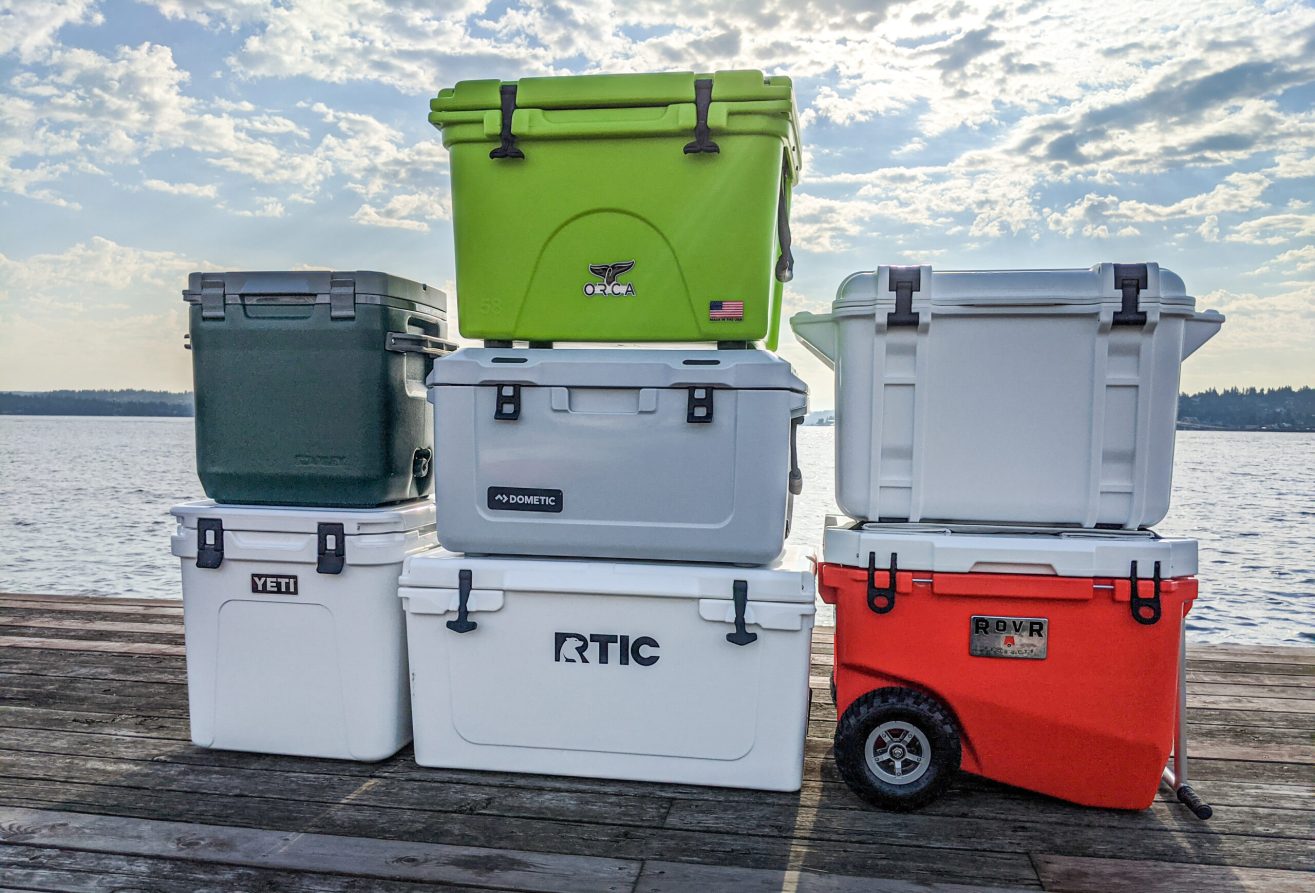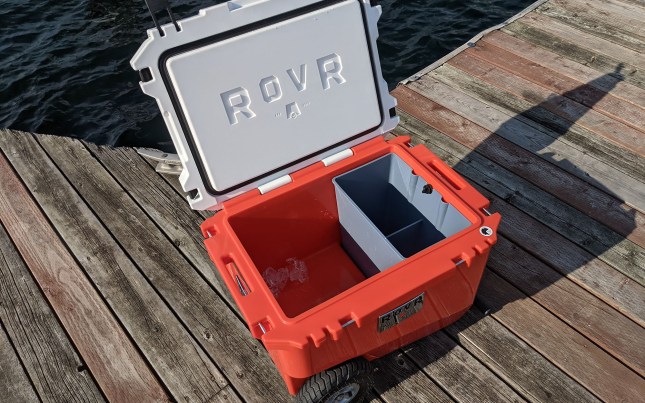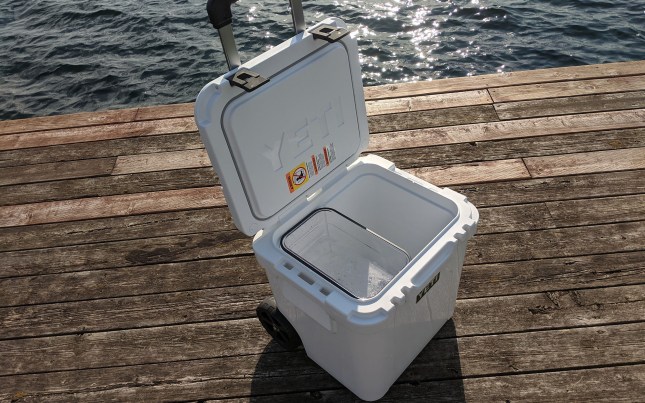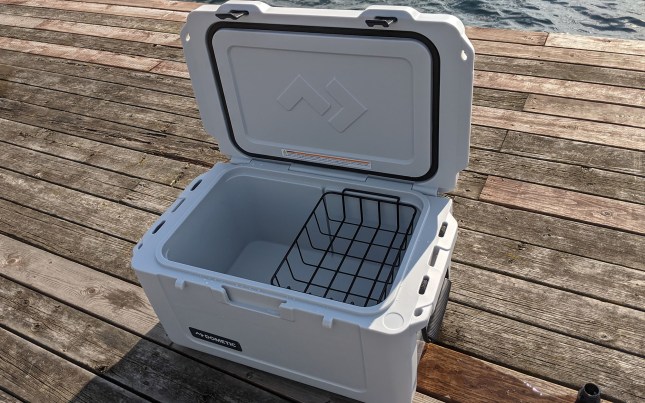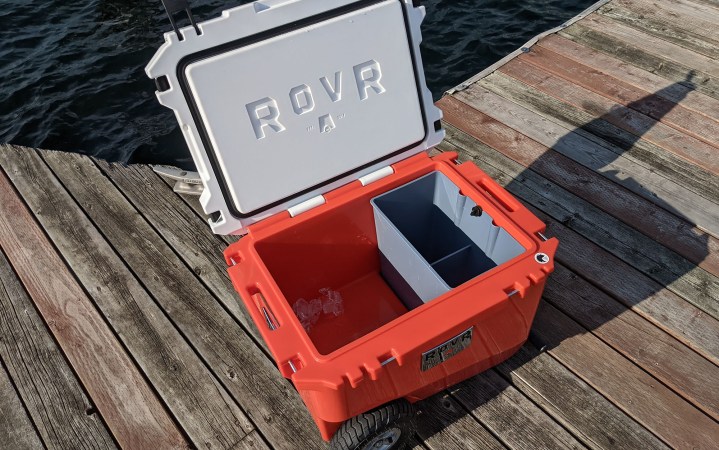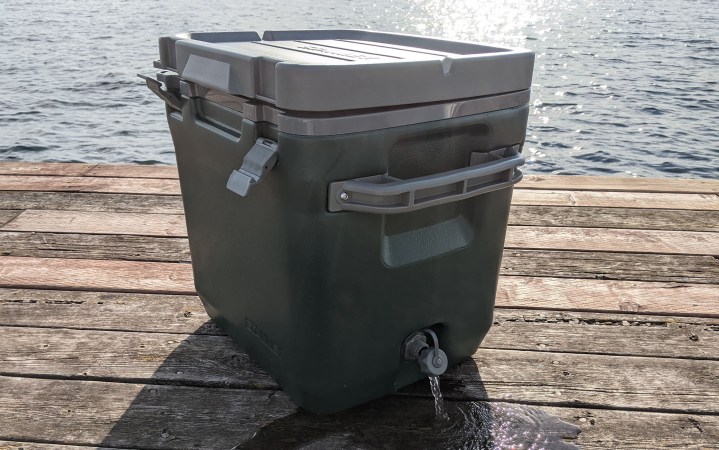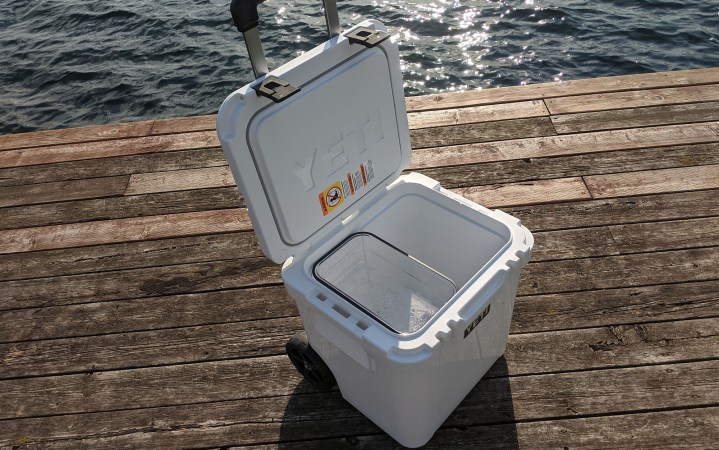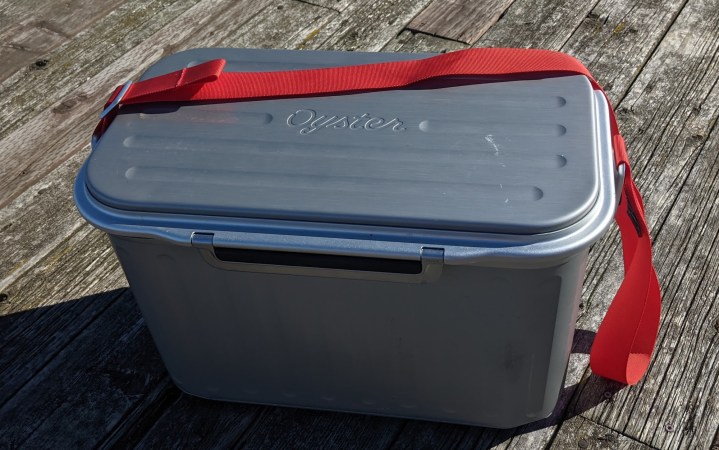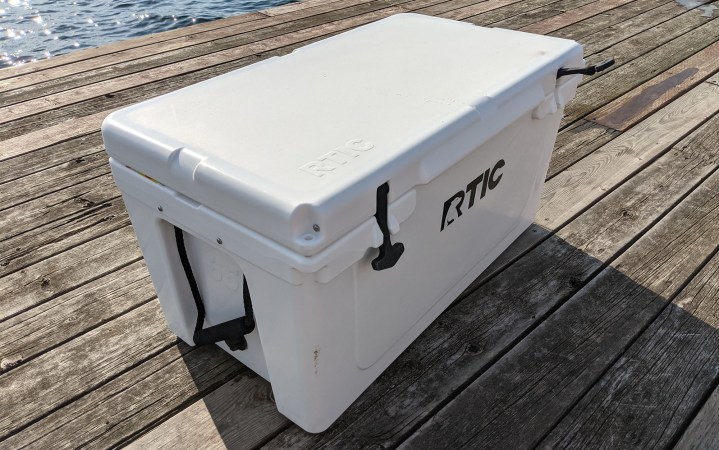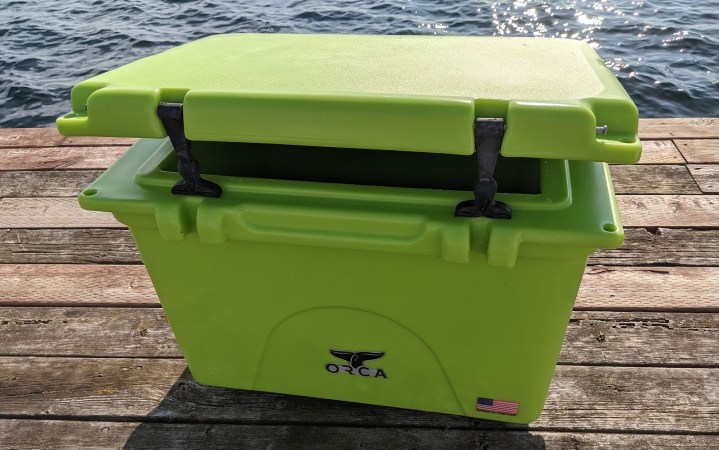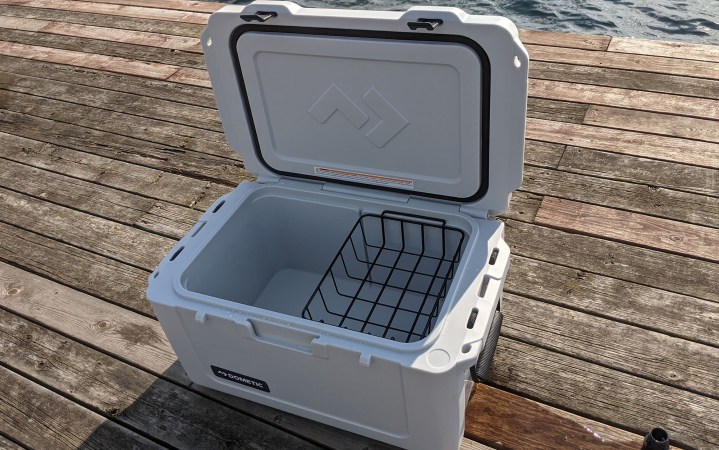We may earn revenue from the products available on this page and participate in affiliate programs. Learn More ›
If you’re heading off grid for a few days or a few weeks, a quality camping cooler is an essential addition to your gear list. Whereas a styrofoam imposter will leave your food soaked in a lukewarm puddle in short order, forcing a return to town or even the end of your trip, a quality cooler will keep your perishables properly chilled for days on end. To help you find the best camping coolers for any camping adventure, I called in the latest models from the top manufacturers to see which would come out on top in a series of tests.
- Best Overall: RovR RollR
- Best for Smaller Cars: Stanley Adventure Cold for Days
- Most Maneuverable: YETI Wheeled Roadie
- Best Lightweight: Oyster Tempo
- Best Value: RTIC Hard Cooler
- Best Water Resistance: ORCA
- Best Budget: Dometic Patrol
How I Tested the Best Camping Coolers
The basis for my test of the top camp coolers was ice retention. To ensure as level a playing field as possible, I put one bag of store-bought ice into each of the seven coolers at the same time and then kept them in the same room. Whenever I checked the ice in one cooler to see if it had melted, I checked it in all of them. Next, I checked how watertight each cooler was, including at the drainage port and around the lid, by filling the cooler with water and then tipping it in a variety of directions. I also screwed and unscrewed the drainage ports multiple times to get a feel for how waterproof (or lack thereof) each was. (Unloading your car only to find a puddle underneath your tent or sleeping bags is not an experience anyone wants.) Finally, I looked at how difficult each latching system was to operate.

While I appreciated the Otterbox Venture’s handles and simple latching mechanism, these features did not stand out compared to others in the test, and it fared the worst during the ice retention test, not quite lasting 24 hours, despite its comparatively bulky insulation.
I also considered the accessories provided with each cooler, how easy it was to transport or move, and the overall cost. Recommendations also took into account the size of each cooler, how easy they were to open and close, and how easy each cooler would be to fit inside of a typical car camping (not overlanding or RV) vehicle.
The Best Camping Coolers: Reviews & Recommendations
Best Overall: RovR RollR
Key Features
- Capacity: 60 quarts (claimed), 52 (measured); 45-quart and 80-quart capacity also available
- Dimensions: 26.5 x 20 x 21 inches (exterior); 19.5 x 10.5 x 12 inches (interior)
- Weight: 49.5 pounds
- IGBC-certified (bear-proof locks sold separately)
Pros
- Best-in-class ice retention
- Wheels make it easily portable
- Excellent drainage
Cons
- Expensive compared to others in our test
- Poor interior volume to exterior volume ratio; interior volume does not match manufacturer-provided measurements of the interior
The RovR RollR was easily the flashiest cooler in my test, with bulky 9-inch wheels, a roller handle, and a convenient pop-top storage bin. But don’t let all the extras fool you: This cooler performed exceptionally in my ice retention test. It took almost two days for a single bag of ice to melt.
The extras in this cooler should be especially appealing to anyone planning to travel into more rugged terrain. The 9-inch diameter wheels made this easier to pull over rooty trails (even given its hefty 50-pound weight). The sitting pad on top of the cooler can also be converted to a stash bin for all the extras you want to transport to your destination. For campers heading farther afield, there’s even an attachment (sold separately) to attach the cooler to your bike.
One unique feature of this cooler is the interior design: The wheels create a step-down shelf on the far side. At first glance, you might think the odd dimensions would make it difficult to pack food efficiently, but its utility becomes clear as the ice starts to melt: the meltwater drips down into the pocket, where it’s easily siphoned off using the drainage port. This helps to keep your food from getting soggy in a pool of melted ice water. A handy vertical basket (provided with the cooler) can be used to store food on the drainage end of the cooler without immersing your perishables, and helps to create a barrier to stop the rest of your food from sliding over. Though unusual, it’s a well-thought-out design.
The biggest drawback to the RovR RollR is the price. It was the most expensive option at the time of testing, which was especially noticeable since its volume when measured out was less than the claimed 60 quarts. Some users may also find the rubber latches somewhat difficult to manage—it took some elbow grease for me to pull them down and up while checking the ice during testing. The drainage similarly caused some issues at first, with ice water leaking out onto the floor, but once I cranked it down the leakage stopped—my takeaway is that straight out of the box the drainage port simply isn’t closed all the way.
All in all, if you’re willing to spend extra to upgrade your camping experience, this is an excellent choice.
Best for Smaller Cars: Stanley Adventure Cold for Days
Key Features
- Capacity: 30 quarts
- Dimensions: 21.5 x 18.5 x 15.5 inches (exterior); 13 x 11 x 12 inches (interior)
- Weight: 13.6 pounds
- Not IGBC-certified
Pros
- Inexpensive
- Streamlined design works well for smaller cars
Cons
- May not have enough storage space for longer adventures
For campers (like me) that have a sedan as their primary vehicle, a three-foot long cooler capable of storing enough of the best camping meals for a family of six for a week is frankly overkill. A family of four would find the Stanley Adventure Cold for Days is the perfect size for a weekend trip with plenty of room to stash snacks for the kids and adult beverages for the parents. Two people would have plenty of room for a longer getaway.
This cooler held its own during the ice retention test, coming in second overall. This is especially impressive as the Stanley Adventure for Days Cooler was one of the few in my test that wasn’t rotomolded (considered by many to be an industry standard in the best camping coolers). In addition, it had several features that I appreciated, including a fairly simple click latching system (no difficulty in managing the rubber latches here). I also liked that the drainage port cap was connected to the rest of the cooler, making it harder for forgetful campers (i.e., me) to lose it over the long haul.
But perhaps the biggest draw of this cooler is its significantly lower price point, a third the cost of the highest-priced cooler in my test (although, given its smaller size, not the best budget pick). If you’re just getting started camping with your friends or significant other, then this is an excellent choice that will last you for years.
Best Features: YETI Wheeled Roadie
Key Features
- Capacity: 48 quarts (20-quart and 60-quart capacity also available)
- Dimensions: 20 x 20 x 20.5 inches (exterior); 14.5 x 11.5 x 15.5 inches (interior)
- Weight: 25.8 pounds
- Not IGBC-certified
Pros
- Good ice retention
- Easy to move around
- Excellent latching mechanism and drainage ports
Cons
- Expensive
One of the biggest drags of any high quality cooler is having to move it around. No matter how advanced your technique (lift from the legs, not from the back), it’s still awkward and uncomfortable. The YETI Wheeled Roadie at first glance looks more like a roller-bag than a typical cooler, and fortunately for you, it’s maneuverability is much more akin to the former. A telescopic handle (the only cooler in my test with this feature) pops up from the top of the cooler and lifts up to an impressive 3.5 feet—high enough for even the tallest campers to grab comfortably. Shorter users have the option to adjust the height down to a more comfortable level. One upgrade here is that the wheels on the YETI Roadie are (thankfully) significantly larger and more durable than those on your suitcase. While checking ice retention, leaks and functionality, this was one of the few coolers that this 5-foot 5-inch tester didn’t dread having to maneuver around.
This was also one of the few coolers in my test to survive two nights of the ice retention test (and would have obviously lasted a lot longer if I had filled it to the brim with ice). Also notable was its simple snap-latch design, which was significantly easier to use than the rubber latches I tested on the other coolers. The drainage port is also waterproof and requires very little torque to operate.
The YETI comes with a basket that sits up top (for your butter, cheese, and other goods that are prone to waterlogging), but can accommodate a second one as well as a divider—useful for storing food at different temperatures. YETI also has a helpful guide on how to pack your ice chest for peak efficiency. If your number one priority in your camping cooler is ease of use, then this is the choice for you.
Best Lightweight: Oyster Tempo
Key Features
- Capacity: 24 quarts
- Dimensions: 20.1 x 11.8 x 12.6 inches (exterior)
- Weight: 12.3 pounds
- Not IGBC-certified
Pros
- Very lightweight
- Space efficient
Cons
- Fragile
- No drainage hole
The Oyster Tempo is an impressive cooler. It maximizes interior storage better than anything I’ve tested. It’s also astonishingly lightweight: even completely full, I was able to carry it on one shoulder using the supplied shoulder strap. But it also has some serious weaknesses, especially for individuals accustomed to using more traditional coolers.
Let’s start with how the Oyster got so light in the first place. Most coolers use polyurethane insulation in between the interior and exterior plastic walls, but the Oyster has nothing inside its walls, not even air. This vacuum seal goes a long way toward preventing heat transfer from one side to the other (it’s also how the best camping mugs and best thermoses are designed). Further, rather than being made from a plastic so heavy duty that you can drop it off a cliff and be no worse for wear, the Oyster is made from a comparatively thin aluminum. For the vacuum seal of the Tempo to be effective, Oyster also eliminated the drainage holes. That means that if you choose to chill your drinks or food with ice, draining the water out will be pretty difficult. For that reason, Oyster recommends using one of the best ice packs for coolers.
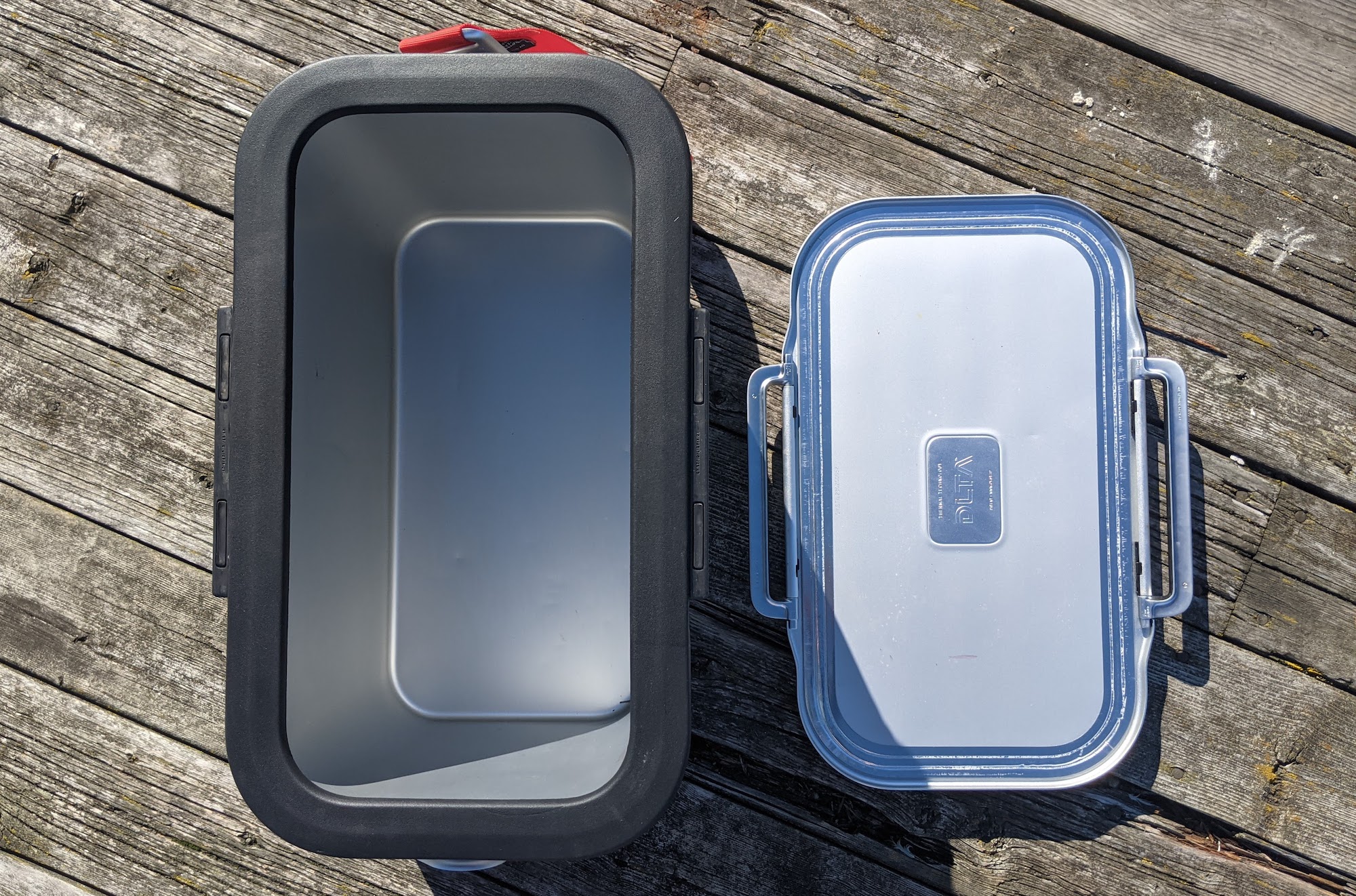
I tested this cooler over a number of camping trips and came away both impressed and disappointed. I loved how small it was, it took up half the space as the Stanley Adventure I had been using previously, and effectively held just as much. It was also very easy to move around, which was helpful on trips when we moved campsites frequently. Finally, the vacuum sealing does work at scale: It did a surprisingly good job at keeping things cool. Filling about half the cooler with ice packs was sufficient to keep everything chilled for up to four days, even at the peak of summer. On trips that were longer than that, we would have to get creative about how to keep things chilled, either purchasing frozen items to stack in next to the milk and vegetables, or dealing with the hassle of melting ice without a drainage hole.
The biggest issues with this cooler are the lid design and how comparatively fragile the vacuum sealed aluminum is. While switching out the ice packs in a parking lot at one pit stop, I picked up the cooler by the lid in order to turn it upside down and let the excess moisture from the coolers’ contents run out. While this is something that most of us have done with other camping coolers over the years, you really should not do this with the Oyster Tempo. On this cooler, the lid opens on both sides, and is held shut by a relatively simple clasp. Holding it by the lid caused the clasp to pop open, and the cooler fell a few feet to the ground. Even empty, this was enough force to dent the bottom of the aluminum shell. While this did not damage the vacuum seal (we used the cooler for the rest of our trip without incident), it was fairly unsightly and spoke to the overall fragility of the cooler. Don’t throw this one off a cliff, or at all.
Here’s the thing, though: even with the issues I had with the lid mechanism and damaging the cooler, I still reached for it again and again throughout the summer. It’s lightweight, spacious design more than makes up for these faults. If you’ve been frustrated by the cumbersome builds of more traditional coolers and are looking to try something new, then this should go to the top of your list.
Best Value: RTIC Hard Cooler
Key Features
- Capacity: 65 quarts (45-quart capacity also available)
- Dimensions: 32 x 17 x 18.5 inches (exterior); 26 x 12 x 13 inches (interior)
- Weight: 36 pounds
- Not IGBC-certified
Pros
- Affordable price
- Large volume works well for larger groups
- Best interior volume to exterior volume in my test
Cons
- No tray insert
- Wide size makes it difficult for one person to move
If all you’re looking for is a giant box to keep your provisions chilled—no bells, whistles, or wheels—then the RTIC Hard Cooler is the right choice for you. It’s a classic rectangular design, which maximizes interior space and uses a simple pair of rubber T-latches with rope and foam handles to haul to your preferred camping location. The longer length of this cooler (almost 3 feet), means that this one will be difficult to haul by yourself, so plan to ask your partner or a friend for help. Like most hard coolers in this category, the RTIC 65 QT Hard Cooler is rotomolded.
While I wish this cooler came with a bin to store the softer provisions you want to keep out of cooler water, RTIC does sell cooler baskets separately on their website (at the time of this review, however, the 65 quart size was not available). They also have dividers (useful if you are bringing food on a trip that you’d rather not have exposed directly to the ice) and a seat cushion for those that like to use their cooler as an impromptu bench.
While the RTIC Hard Cooler performed in the bottom half of testing, it still held ice for an impressive amount of time, long enough for all but the gnarliest camping trips in the hottest climates. I was also impressed by its interior volume to exterior volume ratio, the highest in my test, which helps to make up for some of the loss of insulation. If getting a large cooler at a great price is your top priority, then this cooler is an excellent value.
Best Water Resistance: ORCA Cooler
Key Features
- Capacity: 58 quarts; 20-quart, 26-quart, 40-quart, and 140-quart capacity also available
- Dimensions: 27 x 19.5 x 19.5 inches (exterior); 20 x 13.5 x 13 inches (interior)
- Weight: 36 pounds
- IGBC-certified (locks sold separately)
Pros
- Extremely water-resistant
- Widest variety of sizes available of any cooler in my test
Cons
- Difficult to open
When I first unboxed the ORCA Hard Cooler, I thought there was something wrong with it. No matter how hard I pried at the lid after unhooking the two rubber latches, I couldn’t get it open. Was I going to have to leave this cooler out of my test due to lack of upper body strength? As a last ditch effort, I unscrewed the drainage port: there was an immediate hiss of air, followed by the popping sound of the cooler walls releasing. To say that the amount of pressure this cooler is capable of holding is impressive is an understatement.
Even when filled with room temperature water, this cooler is quite water resistant. During my test for waterproofness, the sides and the back held the water completely in, and only a small dribble escaped the front. However, when the cooler is filled with ice (and hasn’t been opened in a while), the cooler becomes entirely waterproof. The pressure inside the cooler creates a seal similar (if, fortunately, less intense) to when I first unboxed the cooler.
The only downside to this extremely effective water-resistance is that the latches are surprisingly difficult to use, requiring more than some effort to secure. If you’re camping with children (who might not have the strength or patience to operate this cooler correctly), then another choice might be better. However, if you plan to use your cooler on a boat in addition to camping, then this one is a no-brainer, in addition to these coolers for fishing.
Best Budget: Dometic Patrol
Key Features
- Capacity: 55 quarts (20-quart, 35-quart, and 105-quart capacity also available)
- Dimensions: 30 x 19 x 10 inches (exterior); 22.5 x 11 x 13.5 inches (interior)
- Weight: 33 pounds
- Not IGBC-certified
Pros
- Great value
- Easy to use latch
Cons
- No wheels
The Dometic Patrol shared many of the qualities of the RTIC Hard Cooler: a simple design paired with effective ice retention. But while the exterior-to-interior size ratio was not quite as impressive with this cooler as it was with the RTIC, I was impressed at what it accomplished at its price point, almost half of the most expensive coolers in my test. Given Dometic’s earned reputation for producing high-end and high-tech overlanding gear, the affordability and simplicity of this quality camping cooler was a pleasant surprise.
The basket provided by the Dometic was also one of the largest in my test, capable of holding all your sensitive perishables and then some above the inevitable melting slurry. If you’re looking to upgrade your cooler without spending your entire camping budget on one piece of gear then this is a smart pick.
Things to Consider Before Buying Camping Coolers
Size
During testing, very little correlation was noted between the size of a cooler and the amount of time it took for a bag of ice to melt: at this level of performance, it was all about the quality of the cooler itself. So if space is not an issue for you, choose the largest cooler that you think you’ll need. If space can be an issue when you travel, it may make sense to pair a larger camping cooler with one of the best small coolers on the market, to maximize their versatility.
IGBC Certification
If you plan to leave your cooler outside your car in either black bear or grizzly bear country, it’s essential that you choose a cooler that has been certified by the Interagency Grizzly Bear Committee (IGBC). The committee works in coordination with the Grizzly & Wolf Discovery Center to test bear canisters, coolers, and trash cans using live bears to certify those that are bear resistant. If you plan to leave an IGBC-certified cooler outdoors, either overnight or while you are off on a day hike, it’s essential that you lock the cooler—the rubber latches are not designed to hold off a bear alone.
Latching System
I was surprised at the amount of variation in the latching systems among the coolers that I tested. Some, like the OtterBox Venture, were a breeze to use, while others needed a surprising amount of muscle to get into place. A difficult-to-use latching mechanism is unlikely to make a difference to any unwanted diners (like bears) breaking into your food stash (you’ll need a set of bear locks for that). Plus, I couldn’t see any correlation between a trickier latching system and better ice retention. Instead, the best camping coolers have an easy-to-use latching system that ensures you consistently and properly close your cooler. That results in optimal chilling.
FAQs
While the styrofoam coolers from the store only cost a couple dollars, a high-end camping cooler that will last for years (and cause a heck of a lot less damage to the environment) typically ranges from $200 to $500.
For a quality camping cooler, including those tested in this roundup, it’s better to go too big than too small. A larger size will still hold even a single bag of ice for a long time—you don’t need to pack it in to maximize the amount of time it will last (unless you are planning to store perishables for, say, a two week stretch). The main limitation will be the size of your vehicle. In those instances, I recommend going with the best cooler for small cars: the Stanley Adventure Cold for Days.
There are three factors that affect how long a camping cooler will stay cold: the amount of ice (or cooler packs) stored inside of it, the quality of its insulation, and the ambient temperature outside of the cooler. Any of the coolers in this test will keep your perishables cold for a long weekend, while the RovR RollR and the YETI Wheeled Roadie have both the quart capacity and insulation bonafides to keep your goods chilled for a week or more given sufficient ice.
Why Trust Outdoor Life?
Since 1898, OL has been a leading authority in testing and reviewing hunting gear, fishing tackle, guns and shooting equipment, and much more. We have more than a century-long history of evaluating products, and we’re now bringing that expertise to online reviews. Our editors are experienced outdoorsmen and women, and most importantly, we’re trained journalists. We prioritize field testing and objective data when reviewing products. We conduct interviews with gear manufacturers and engineers as well as outdoor experts so that our readers have an understanding of how and why a product works—or doesn’t.
Advertising does not influence our gear reviews and it never will. While we always focus our coverage on standout products—because we want our readers to be aware of the latest and greatest gear—we also cover the flaws and quirks of any given product.
Final Thoughts
After testing the best camping coolers from the most respected brands, I’m confident that the RovR RollR is the best choice for adventurous families. The Stanley Adventure Cold for Days is an excellent low-cost pick that will serve couples well, and the RTIC cooler provides excellent value for anyone who wants to maximize their cooler space. When choosing a cooler, consider what size you are likely to need, the importance of long-term ice retention, and the relative importance of a top-notch cooler in your overall camping budget.
- Best Overall: RovR RollR
- Best for Smaller Cars: Stanley Adventure Cold for Days
- Most Maneuverable: YETI Wheeled Roadie
- Best Lightweight: Oyster Tempo
- Best Value: RTIC Hard Cooler
- Best Water Resistance: ORCA
- Best Budget: Dometic Patrol
